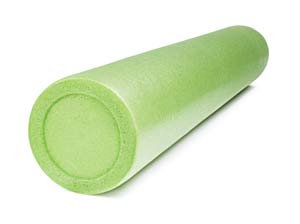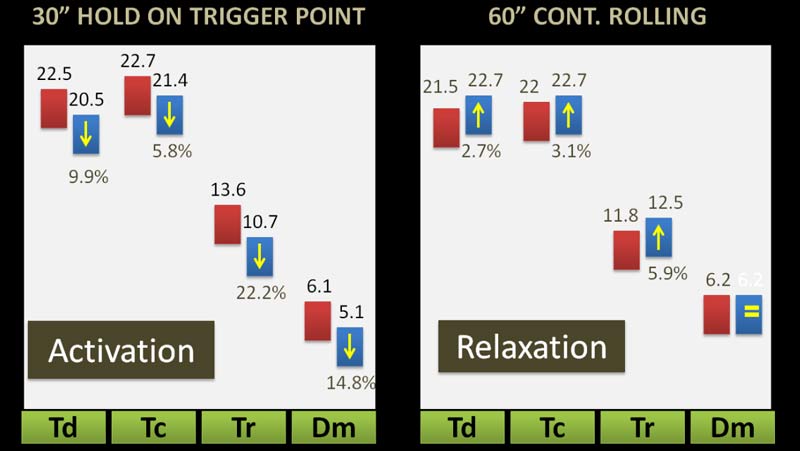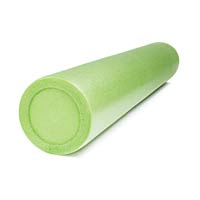
By Carl Valle
Does it work for Speed and Recovery?
Look at any fitness equipment catalog or training center, foam rollers are placed near open spaces like any other tool and this is a sign of acceptance. Twenty years ago this was not the case, but since the late 1990s the popularity grew to what it is today. Research is conflicting and best practices of when and what to do with self therapy tools like foam rollers is subject to debate, but the best way to evaluate anything is field testing and looking at the research carefully. A lot of different opinions on self therapy approaches exist, but very few are specific enough to actually share scientific evidence what may work, or, show the results of adding it to a program. In this article the applied sport science perspective will be the driving force to seeing what we can do with the specific modality of applying pressure to muscles. Using a field testing perspective, as well as looking at the research, a practical review can guide athletes and coaches to reasonable conclusions.

The Anatomy and History of a Foam Roller
Foam rollers are not new, and they were Physical Therapy tools for balance and other forms of rehabilitation before they became self-therapy tools. The commonly used in three foot cylindrical tools for self-therapy. They are commonly used to apply pressure on by lying on them with a combination of bodyweight and sliding motion to manipulate the forces. Polystyrene and molded foam are common materials, with the later material more dense and durable, but a little hard to areas that may have soreness or severe damage. The increase or decrease in diameter and composite of the foam rollers will increase or decrease the hardness. Athletes do this at different times of the training session; mainly during warm-up and warm-down periods to improve what people call “tissue quality”. The first time I heard or witnessed the use of foam rolling was in 1997 in Tampa, when Mike Clark (now Dr. Clark) demonstrated the use to improve muscle tone or function. After trying it I felt it was a little uncomfortable at first, but after a few sessions I learned to apply just enough pressure and my legs felt a bit better. As we approach 20 years later, very few studies have shown the true benefits and the sport science community is not much closer to understanding what is going on a the cellular or organ level with massage, never mind foam rolling, an area less investigated.
How Foam Rollers became Popular
For a 100 years sports massage continues to be researched because athletes swear by it but scientists don’t know what exactly it does. Coaches and athletes believe it works, and some sports medicine experts believe that manual therapy, or using the hands to manipulate the status of tissue, is the cornerstone to performance and athlete health. Access to massage is not easy, because qualified people may not be conveniently available. Massage is expensive because the results are often temporary, and unlike training, can’t be scaled beyond the one to one ratio of therapist to client. Efforts to scale massage by a consumer level approach with foam rollers is great to help provide a benefit, but how much and how well foam rollers work is a bit of an enigma. When foam rolling became scaled as self therapy or coachable massage, the popularity blew up along with the influx of experts touting it’s benefits—and their educational products and services—supported by catalogs to drive sales. Now all levels of trainees, from young athletes to old personal training clients are rolling on the ground to get tissue quality, but does this really work and if so how much does it benefit?
Testing Tissue — What happens to muscle when we apply external pressure?
Look at any elite track and field competition over the last century you will see a gamut of massage or sports therapist kneading and stretching tissue, in order to get optimal tone. At the highest level fine tuning a muscle in theory can be the difference of making the podium and coming home empty handed, so athletes and coaches will find anyone who in their mind can provide the best rub. It may sound that I don’t believe in massage because of the language used above, but I swear by it and have the evidence to back up the benefit with both science and history. I have worked with a soft tissue therapist who has had the magic touch and tested him with several muscle diagnostic devices to prove that he is doing what we all knew deep down was doing. Several experts have cited research that massage doesn’t do anything and I agree with much of the research that it doesn’t do what the investigators hypothesized. If the scientists talked to a few elite coaches we wouldn’t be stuck looking at DOMS (Delayed Onset Muscle Soreness) or blood flow changes. Also if they researched qualified therapists and not random PT or local massage people who spread oil and play Navajo flute CDs, we could see what real therapy does. The good news is that some recent studies with intelligent designs have revealed some promising results, and my own personal quest of finding what really works in sport is confirming everyone’s suspicions. What we know is that some physiological responses happen with massage, and we can assume that foam rolling can help provide similar (most likely less) results that sports massage provides. With sports massage having a wider amount of research, we will use that information along with the specific foam rolling literature to create a logical conclusion.
The Human Touch — What does it do?
I have called my therapist King Midas after one of his clients won a gold medal years ago, and applying pressure on tissue does have a real measurable and observable response. A gentle massage to premature babies show biochemical and autonomic change with a few minutes of light touch, indicating something happens when our skin is in contact with another person. Countless studies show how pressure can trigger responses and some of them are positive and some are negative. Mike Boyle pointed out that several poor treatments have elicited bruising by licensed therapist, suggesting that even trained people are not always doing what we hope they will. On the other hand, how many modalities have we done in the past that deliver nothing at all? Here are several responses that massage can do and how they benefit athletes.

Acute Change in Stiffness and Viscoelastic Muscle Status — The “Holy Grail” people talk about is optimal tone for sprinting. Sort of a Goldilocks scenario of being “just right” a good massage seems to be just deep enough to remove local tightness but leave the legs still responsive to train or compete. Muscle, like any other material, is a biological tissue with a specific composition that changes from outside factors. We all have woken up stiff after a hard training session with sometimes a little soreness, and the changes are usually not favorable for performing. Outside of fatigue, the muscles themselves loose optimal tone that enables maximal speed. Studies of soccer players after games and recovery modalities show sometimes after enough time general power returns with jump tests, but speed is more sensitive and requires a more demanding environment to be optimal.

Changes to Cortisol and Stress hormones — Some interesting hormonal changes happen acutely, and it’s hard to separate the placebo effect of a good rub. How long the effect is with massage lasts and what compound effect of adaptations they provide is currently unknown, but recent studies are hinting that some mixed responses can be attributed to mechanical loading to tissue. What we do know on average a decrease in cortisol and various other hormones and immune responses will statistically change, but how much real world effect is a mystery. Cortisol is a commonly used hormone that is part of an array of responsibilities of the body and chronic elevation is not optimal. I have seen favorable endocrine changes with daily testing and weekly blood draws with athlete who are profession (read mega budgets) so how much does this come into play with foam rolling is unknown. I have found that light rolling biochemically does nothing but chronic pain suffers may have a psychological effect if combined with thermotherapy and other modalities. Pain may be mediated temporarily with ischemic pressure, but no positive biochemical changes are happening at the cellular level that can help long term.

Improvement in Autonomic Environment — Massage and other therapies can elicit an acute change and lasting effect on the autonomic nervous system of the body. The Autonomic system or ANS is part of the peripheral nervous system of the body that provides necessary involuntary changes that help the body function in tasks that keep the body healthy. While the summary of the ANS is hardly perfect, the fight or flight response shared earlier is a sympathetic part of the body, both work to create changes needed to accomplish situational needs and is nearly oppositional to the autonomic system. It’s not that one is bad or good, since even cortisol has important roles and is often seen as a bad hormone, it’s the balance between the two that matter. It can be simply summarized that getting a better parasympathetic state (favorable ANS state) after intense training will help recovery, and a high sympathetic state is great during the heat of the moment.
While the research is helpful, it’s important to actually test the responses one is thinking they are doing from the publications and see if what is being done in the trenches is showing the same results. Remember studies show in a controlled environment what is possible, not what is going to happen when you apply a similar application. Research studies are written so one can replicate the study, but sometimes the design can’t be replicated in an applied sports model. It is also important to create a ranking system of what is the most effective; meaning just because something works, doesn’t mean it works well. A massage session may work acutely, but does it last the next day or does work better than other options? A control is basically a comparison of nothing versus something, and in sport, people are always trying to do something if they are trying to win. It’s not about what works, it’s what works better than other options. With massage being and expertise that has expense and limit in scaling with large teams, foam rolling is promising but far from perfect. Other tools like softballs and objects that provide stimulation to tissue are commonly used to help decrease tone or add pressure to trigger points, how effect they are is obvious, if they worked well or solved the problem it would be used sparingly. What we know is that muscle tone is transient and doesn’t last long, so constant application of muscle therapy is happening all over sport since athletes train daily for the most part and even daily treatments become undone.
Does Self-Myofascial Release help with Recovery and Speed?
Now that we have some general understanding of massage and the effects on the body, mainly on the muscle tissues, does it foam rolling help with recovering the body and improving performance? A logical question is how is a device helping both raise performance (sympathetic output) and recovery (parasympathetic reponse)? One answer is that pressure may range from light gentle work that relaxes to something stimulatory, that activates muscles, so both are theoretically possible. Another point to consider is what field tests and what lab like measurements will show a worthwhile change, an effective response that actually gives something to athlete they can really use. Before we get into what foam rolling does and perhaps other tools, we need to define recovery and define performance, so that we are not lost in vague understanding.
- Athlete Recovery — A lot professionals use vague terms or suggestions use “recovery” as a term to explain something that is very complex and multifaceted. Recovery can range from fueling, mental and emotional concerns, rehabilitation, and the repair and regeneration process of muscular tissue. Nobody will think that foam rolling is restoring glycogen stores or accelerating muscular repair, so tone is likely to be the only variable managed.
- Athlete Performance — Increasing performance can be summarized by increase of consistent output, and anything that improves performance is considered ergogenic. Adaptations from training, nutritional supplements (legal and illegal), equipment, and even strategy and skills are performance enhancers. Foam rolling may help modulate tissue tone for optimal function and or help activate muscle groups with pressure as part of a warm-up procedure.
Foam Rolling — What the Published Research Says
Currently foam rolling is shown not to increase hamstring flexibility, but helps with quad flexibility acutely and over ten minutes. The estimated change was about ten degrees, something that is very real world but how lasting it is yet to be seen. Activation wasn’t seen in the study investigating range of motion of the quadriceps before training, but after heavy training it was seen to be beneficial in jumping, range of motion, and muscle activation during the recovery period. All of the controls in the aforementioned studies were basically doing nothing, so the question is what is foam rolling doing that conventional exercise does not provide? I would guess that conventional warm-ups or recovery activities, designed purposely to do similar responses that foam rollers are trying to do, will make the differences negligible. It is well known that intense exercises can enhance acute performance after (known as PAP) and gradual warming up changes muscle viscosity slightly. So a good control for sport is not nothing, just what people do normally in addition to passive subjects for comparison. The best research designs usually involve a control, a common option, and the unique option in addition to what is done. What additional benefit does foam rolling really do? The scientific research has no real body of evidence to clearly say what, so we have to look at internal or small experiments.
Foam Rolling — What the Private Experiments Tell Us
I do use foam rolling sparingly as it serves a small roll in a big picture, but I have found that the best information comes from a shrewd coach or clever therapist who use their own measurement tools and approaches to share information. As someone who likes speed in all forms, I like timed sprints, power tests, and the best tools to measure peripheral muscle status. I have used thermography, tensiomyography, electromyography, elastography, and digital palpation with a myoton device. All of those tools listed measure different qualities of muscle, and some have similar data and some completely different. Additional invasive and non-invasive tests such as Galvanic Skin Response (GSR), Heart Rate Variability (HRV), and blood/saliva have yielded some information. Several colleagues have repeated experiments and I am seeing more and more collaboration with lab grade technology to accelerate understanding of elite sport by measuring top athletes with actual real world protocols. Remember elite athletes usually have elite therapists, so a foam roller is usually a convenient option or addition to a comprehensive program. Most college and high school athletes that don’t have access to high frequency and quality massage will need to use foam rolling slightly to help optimize training and recovery.
It’s not that the research on foam rolling is not useful, but they are not designed to tell us everything though. Some of the design set-ups are a little incomplete, and some of the tests are not evaluating speed and agility, so nothing beats good sprint timing and jump scores. In addition my own warm-ups are not 10-15 minutes because those simply don’t do enough to get the body ready, but if you look at some professional sports, maybe they are unfortunately realistic. Finally the muscles rolled are superficial and mainly lower body.
Measurement
|
Physiological Response
|
Change
|
Thermography
|
Muscle Temperature
|
None
|
Tensiomyography
|
Muscle Contractile Status
|
Mixed Changes
|
Digital Palpation (Myoton)
|
Muscle Tone & Elasticity
|
Mixed Changes
|
Elastography
|
Muscle Changes
|
None
|
Heart Rate Variability
|
Favorable Parasympathetic Tone
|
Decrease
|
Galvanic Skin Response
|
Sympathetic Arousal
|
Moderate Increase
|
Hormonal (Saliva)
|
Anabolic Endocrine Responses
|
None
|
Lower Body Power (Jumps)
|
Maximal Leg Power
|
None
|
Speed (Fly & Acceleration)
|
Maximum Velocity & Acceleration
|
None
|
The list of measurements charted above are not exhaustive, but they are repeatable and wide enough to cover the most likely variables manipulated by foam rolling. What we know is all of the above responses will be increased by a complete warm-up using just he body and space. Adding a foam roller may help, but the changes are not going to be as wide so the hope is that it improves one or two areas more than just warming up alone. We know the changes are not going to be long lasting or extremely powerful, but so long as they are enough to complement existing warm-ups, it’s worth the added few minutes. Most sports are trying to reduce injuries and increase performance by optimizing, so absolute sports like track and field may likely need good hands to do work that simply lying on a tube can replicate. Something is usually better than nothing, so I find the short one foot roller to help with the anterior thigh and posterior hips.

Figure 1: Myofascial Activation and Relaxation
Tensiomyography, or TMG for short, is one option that shows contractile muscle dynamics by estimating the motion of the muscle after a contraction. After the sensor collects and samples the tissue response to electrical muscle stimulation, it breaks down the time course of muscle displacement into smaller metrics or measurements. This process is a good indication or summary of neurological status of the muscle, but it can’t show changes to parts of the muscle like the Myoton does or see areas of inflammation like elastography. Regardless, the small internal study performed by Jose Fernandez of Haloview shows that different rolling protocols will affect the muscle characteristics after treatment, another variable to think about.
How to include Foam Rolling into a Training Program
The benefits of foam rolling is mainly on manipulating tone and that is mainly reducing it if done right with just enough pressure to relax the tissues but not too much to cause pain. You can do foam rolling at any time technically, but it’s better to use limited warm up time doing total body movements versus individual adjustments to tone. At moments when warm up is not restricted because of time, fine-tuning a few trouble spots found during the warm up is logical. If one wants to increase activation one can do use it, but conventional warming up process will cover most of the bases. It’s best to add foam rolling as way to fine tune but be careful of taking away time from doing what works. “Robbing Peter to pay Paul” usually doesn’t amount to anything more. Foam rolling is very specific and local, meaning it only helps one muscle at a time and doesn’t help the neurochemistry that much, something that general movement is more effective doing. It’s better to manage too much tone from heavy training on muscles that seem to respond well such as the quads, adductors, and glutes rather than foam roll hamstrings and upper body muscles. Placing the foam rolling at the end of a workout will help address tone before the next session by areas that are higher in stiffness in advance. Foam rolling represents a very small part of training, and remember to use it purposely rather than just doing it because everyone else seems to.
Please share this article so others may benefit.
[mashshare]


